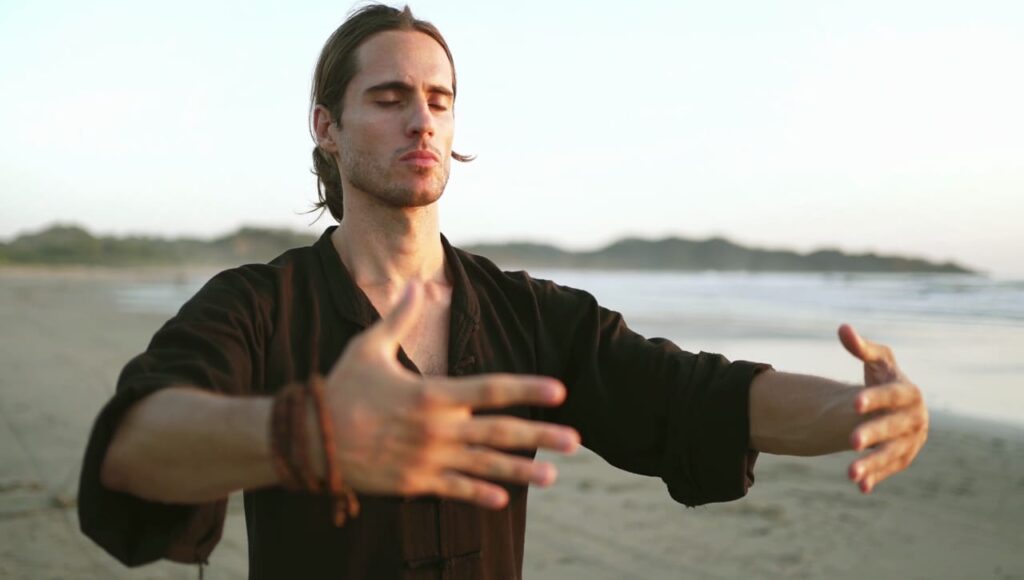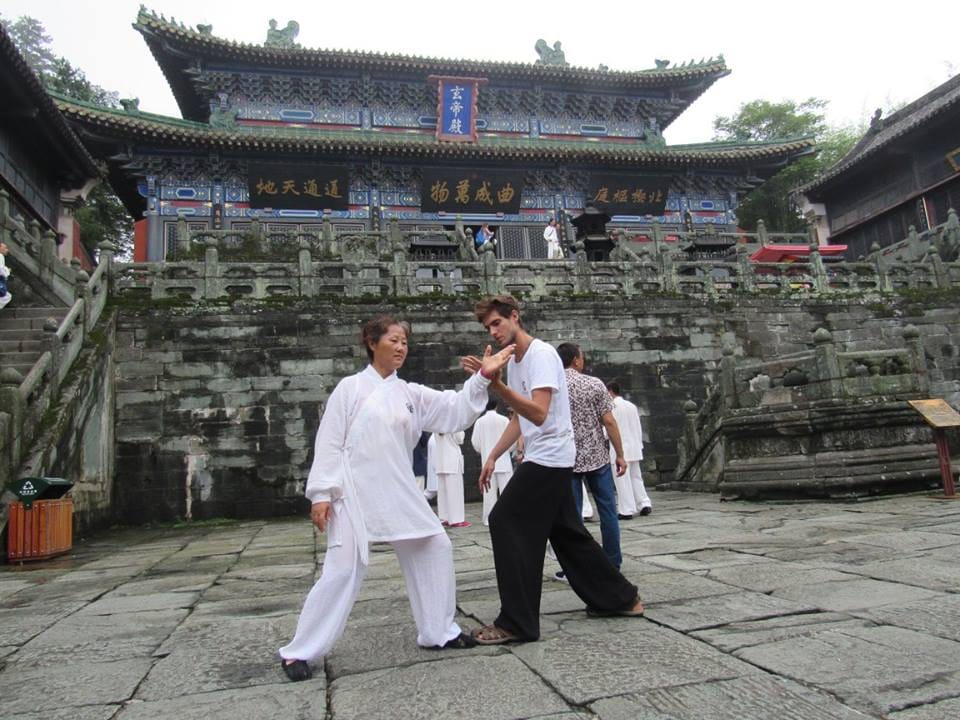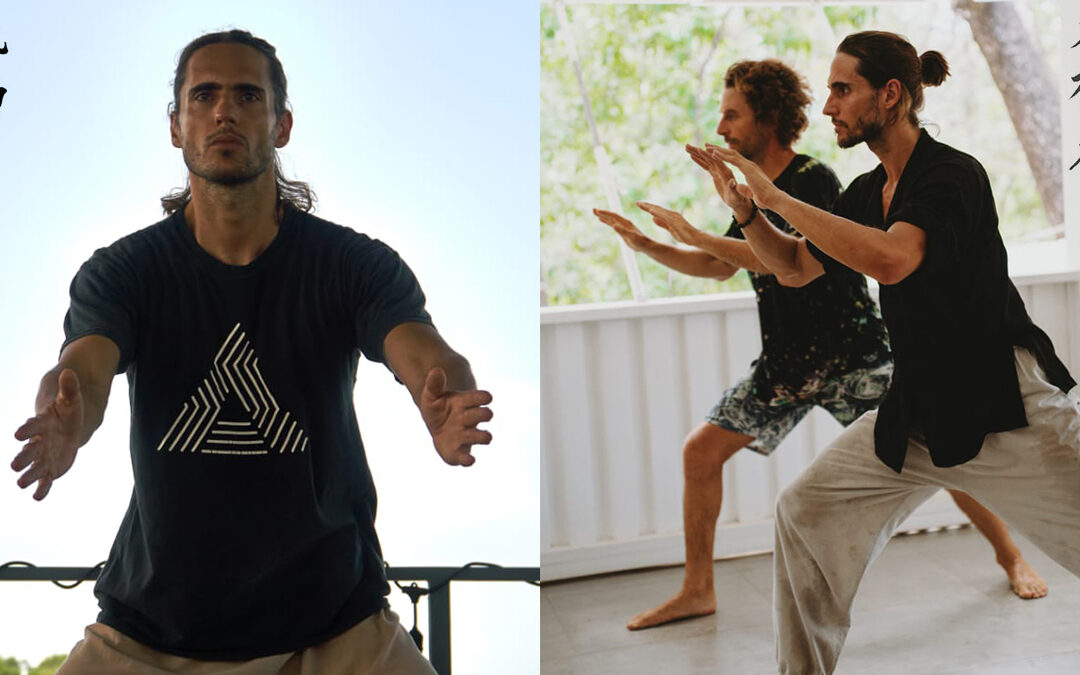The Quick Answer (TL;DR)
- Qigong Qigong (氣功 Qìgōng): A wide family of practices—medical, spiritual, and martial—focused on cultivating Qi (vital energy). Often simple, repetitive movements or static postures combined with breath and intention.
- Tai Chi (太極拳 Tàijíquán): An internal martial art that integrates Qigong principles into long, choreographed sequences (forms) with martial applications.
- Relationship: Tai Chi is like a specialized branch of Qigong. You can practice Qigong on its own for health and meditation, or Tai Chi if you want a structured art that blends energy work with martial principles.
Qigong is the broader art of “cultivating energy” through movement, breath, and awareness. Tai Chi is an internal martial art that applies Qigong principles within a choreographed form, originally designed for self-defense but now widely practiced for health and longevity.
In other words: all Tai Chi contains Qigong, but not all Qigong is Tai Chi. Understanding this relationship helps clarify why these practices feel similar, yet offer different entry points depending on your goals.
“The soft overcomes the hard; the gentle overcomes the rigid”.
Tao Te Ching, Chapter 78
This Daoist wisdom captures the essence both arts share: learning strength through softness, and finding balance in motion.
Tai Chi vs Qigong: Key Differences
| Aspect | Qigong | Tai Chi (Taijiquan) |
|---|---|---|
| Origin | Ancient China, over 4,000–5,000 years ago; rooted in Taoism, Buddhism, and TCM | Chen Village, 17th century; influenced by Qigong, Daoist philosophy, and martial arts |
| Philosophy | Balance of Yin-Yang, harmony with nature, cultivation of Qi | Yin-Yang in motion, softness overcoming hardness, martial application |
| Energy Concept | Qi (vital energy, “wind of life”) | Qi cultivated and directed through martial forms and intent (Yi) |
| Practice Style | Short sets, repetitive or static postures, standing/sitting meditation | Long choreographed forms (24, 48, 108 moves), includes push-hands and applications |
| Purpose | Health, meditation, inner cultivation, martial conditioning | Martial art with integrated health benefits |
| Accessibility | Very accessible, adaptable to all ages and physical levels | Requires more time to learn forms, but still low-impact and gentle |
| Branches | Medical, Spiritual, Martial, Scholarly | Chen, Yang, Wu, Sun, Wu/Hao styles |
Philosophical Foundations: Yin-Yang, Wuji, and the Way of Nature
Tai Chi and Qigong are not just movement systems; they are physical expressions of Daoist philosophy. At their core lies the search for harmony — between yin and yang, stillness and motion, body and mind.
Wuji (The Primordial State)
Both arts begin from Wuji — the posture of emptiness and stillness. In Qigong, Wuji is the neutral standing stance, the “seed posture” that allows energy to circulate freely. In Tai Chi, Wuji represents the state before movement arises, the source from which the form unfolds.
“We shape clay into a pot, but it is the emptiness inside that holds whatever we want”.
Tao Te Ching, Chapter 11
This teaching mirrors the role of Wuji: it is the emptiness that gives birth to possibility, the stillness that allows motion.
Yin and Yang in Motion
Once Wuji gives rise to Taiji — the Supreme Ultimate — yin and yang appear. Every movement in Tai Chi and Qigong embodies this polarity: when one arm expands, the other contracts; when the body rises, it must also sink. This constant interplay reflects nature’s rhythm: day and night, inhale and exhale, action and rest.
Song and Jing
Teachers often speak of Song (relaxed expansion) and Jing (quietude of mind). These qualities allow the practitioner to release unnecessary tension, open the joints, and quiet the mind. Song creates space in the body for Qi to flow; Jing creates space in the mind for awareness to settle.
Wu Wei: Effortless Action
Another Daoist principle central to both arts is Wu Wei, often translated as “effortless action” or “non-forcing.” In Tai Chi, this means yielding instead of resisting, redirecting force instead of clashing. In Qigong, it is the ability to let breath and energy flow naturally, without strain.
“The Way never acts, yet nothing is left undone”.
Tao Te Ching, Chapter 37
Through Wu Wei, practitioners learn that true strength lies not in tension but in alignment with the natural flow of energy.
Shared Spiritual Roots
- Daoism gave Qigong and Tai Chi the language of yin-yang, qi, and harmony with nature.
- Buddhism added the focus on meditation, mindfulness, and reducing suffering.
- Confucianism emphasized discipline, virtue, and self-cultivation.
Together, these philosophies shaped practices that are not only exercises but also living wisdom traditions — ways to embody balance, presence, and harmony with the Dao.
History and Origins
Qigong: The Ancient Root
Qigong traces its roots back more than 4.000 years, making it one of the oldest continuously practiced systems of health and self-cultivation in China. It developed from a fusion of Daoist internal alchemy, Buddhist meditation practices, and Traditional Chinese Medicine (TCM).
- Daoism emphasized living in harmony with nature, cultivating vitality, and extending life through breath and energy practices.
- Buddhism, especially Chan (Zen) traditions, introduced meditative Qigong as a way to quiet the mind and awaken presence.
- Traditional Chinese Medicine integrated Qigong into its healing system, using it to regulate energy (Qi) through the meridians, complementing acupuncture and herbal remedies.
Over centuries, Qigong diversified into four main branches: medical, spiritual, martial, and scholarly. Each shares the same foundation — regulating body, breath, and mind — but adapts to different goals: from healing illness, to refining consciousness, to strengthening martial power.

Tai Chi: From Village Art to Global Practice
Tai Chi (Taijiquan) is much younger than Qigong, yet it grew directly out of Qigong and Daoist principles. The most widely accepted history points to the Chen family village in Henan, China, during the 17th century.
- Chen Wangting (1580–1660), a retired military officer, synthesized martial techniques with breathing exercises, energy circulation, and Daoist philosophy. The result was a new art that combined self-defense with internal cultivation.
- In the 19th century, Yang Luchan (1799–1872) learned the Chen family art and adapted it into a more accessible style, which spread rapidly across China and later the world. His disciples went on to found other major styles, including Wu, Wu/Hao, and Sun.
Today, five traditional lineages of Tai Chi are recognized: Chen, Yang, Wu, Wu/Hao, and Sun. Each retains the same philosophical roots but emphasizes different qualities — from Chen’s spiraling power and explosive fa jin, to Yang’s broad, graceful movements, to Sun’s agile, upright steps.
In 2020, UNESCO recognized Tai Chi as part of the Intangible Cultural Heritage of Humanity, affirming its value not only as a martial art but also as a global treasure of health and cultural wisdom.
Shared Foundation
Despite their different timelines, Qigong and Tai Chi are deeply intertwined. Qigong provided the energetic, philosophical, and meditative base; Tai Chi refined those principles into a martial art expressed through continuous, choreographed forms.
In this sense, Qigong is the root system, and Tai Chi is one of its most fruitful branches.
Martial Qigong: The Engine Behind Internal Arts
When people think of Qigong, they often imagine slow, gentle movements for relaxation or health. While this is true, Qigong also has a martial dimension that is less well known but just as important.
What Is Martial Qigong?
Martial Qigong (Wu Gong Qigong) refers to practices that cultivate internal energy, structural power, and resilience specifically for Martial Arts. Instead of building muscle through external force, martial Qigong trains the body to generate power from within — through alignment, breath, and intention (Yi).
Qigong is and always will be the heart of Chinese martial arts. It is where we learn to understand our body, how to heal and strengthen it, and how to experience the nature of breathing and, subsequently, the proper use of the mind.
Examples include:
- Iron Shirt Qigong: conditioning the body to withstand strikes by aligning bones, tendons, and fascia while circulating Qi.
- Fa Jin practice: short explosive releases of power that originate from the dantian (energy center) and whole-body connection.
- Tendon and ligament training: strengthening connective tissues for martial efficiency and longevity.
Tai Chi as Martial Qigong in Motion
Tai Chi can be seen as a highly refined form of martial Qigong. Every Tai Chi movement — from “Ward Off” to “Single Whip” — is both a health exercise and a self-defense technique. The form is designed to train:
- Yielding and redirecting force (yin)
- Issuing power softly but decisively (yang)
- Coordinating mind, energy, and body as one
As the Tai Chi Classics state: “Use mind, not force. When the mind leads, Qi follows. When Qi flows, the body responds.”

Beyond Tai Chi: Qigong Across the Martial Spectrum
It’s important to note that Tai Chi is not the only martial art rooted in Qigong.
- Shaolin Kung Fu integrated breathwork and dynamic Qigong for stamina and striking power, nei gong, and Zen Buddhism.
- Wudang Kung Fu blended Taoist meditation, Qigong, and martial practice into a unified system.
- Other internal styles like Bagua Zhang and Xingyi Quan also rely on Qigong principles for power and fluidity.
Why It Matters
By highlighting the martial dimension of Qigong, we avoid the misconception that only Tai Chi is martial. Qigong is the engine; Tai Chi is one of its vehicles. Both share the same fuel — the cultivation of Qi — but Tai Chi expresses it in a codified martial art, while Qigong remains the broader training ground that nourishes many disciplines.
“The soft overcomes the hard; the gentle overcomes the rigid”.
Tao Te Ching, Chapter 78
In Martial Qigong, this principle is not abstract philosophy but a practical strategy for training and combat.
Shared Benefits of Tai Chi and Qigong
Although Tai Chi and Qigong differ in form and focus, they share many of the same health benefits. Both are known to:
- Reduce stress and improve emotional balance
- Support better sleep and relaxation
- Enhance balance and coordination, lowering the risk of falls
- Strengthen legs, joints, and posture with low-impact movement
- Improve focus, attention, and overall mental clarity
These practices are often described as “meditation in motion” combining gentle exercise with mindful breathing to support both body and mind.
If you’d like to explore the science in more depth:
- Read our dedicated post on the Health Benefits of Tai Chi.
For many practitioners, the best choice is not either/or but both together. Qigong builds the foundation of breath, awareness, and Qi flow. Tai Chi applies those principles in a martial framework, adding depth and structure. Practicing them side by side creates a complete path to health, mindfulness, and personal growth.
“The Way never acts, yet nothing is left undone.”
Tao Te Ching, Chapter 37
Which One Should You Choose?
Both Tai Chi and Qigong are powerful tools for cultivating balance, energy, and inner calm. Which one you choose depends on your goals and preferences:
- Choose Qigong if:
- You want to learn basic foundations about your posture, breathing and mindfulness.
- Your focus is primarily on health, relaxation, and meditation.
- You’re looking for some posture and movements to support recovery, chronic conditions, or daily stress relief.
- Choose Tai Chi if:
- You enjoy the way of movements of the Taichi
- You want to explore an internal martial art with applications in self-defense.
- You’re interested in developing both physical grace and deeper energy work through movement.
Frequently Asked Questions
Is Tai Chi a type of Qigong?
Not exactly. Tai Chi is an internal martial art that uses Qigong principles, but Qigong is broader and not always martial. You can practice Qigong without Tai Chi, but Tai Chi always includes Qigong elements.
Which is easier to start with?
Qigong is usually the first step when you want to start any traditional Chinese internal art. Because it is the method to learn how to organize your body structure by standing practice; exercises that help us to “open the body” preparing the joints, muscles, tissues and tendons, and also for learning the correct mindset for the internal training.
Can Qigong also be martial?
Yes. Martial Qigong trains strength, resilience, and explosive power. Tai Chi itself is considered martial Qigong in motion.
How long until I feel benefits?
Most people notice improvements in relaxation, mood, or balance within 8–12 weeks of consistent practice. Long-term benefits build with daily or weekly practice.
Can I practice both Tai Chi and Qigong?
Absolutely. They complement each other. Many practitioners use Qigong as a foundation and Tai Chi to explore movement, martial structure, and deeper energy flow.
Do I need to believe in “Qi” to benefit?
No. You can frame Qi as breath, body awareness, or internal energy. Even skeptics experience the physical and mental benefits of these practices.

